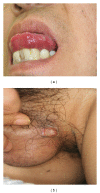A New Diagnostic Way for Behcet's Disease: Skin Prick with Self-Saliva
- PMID: 24587910
- PMCID: PMC3920895
- DOI: 10.1155/2014/581468
A New Diagnostic Way for Behcet's Disease: Skin Prick with Self-Saliva
Abstract
Behcet's disease (BD) is a mysterious multisystemic disorder characterized by recurrent involvement of mucocutaneous (including recurrent aphthous stomatitis; RAS), ocular, intestinal, vascular, and/or nervous system organs. Previously, the positivity of "pathergy test", which is one of the diagnostic examinations, was reported to be related to the possession of HLA-B51 gene in BD patients, even though the positivity is low and different from the countries. Here, instead of the ordinal pathergy test, we would like to propose the prick with self-saliva as a new diagnostic way for patients with RAS of BD based on the genetic intrinsic factors including HLA-B51 and extrinsic triggering factors. BD patients are considered to acquire the hypersensitivity against oral streptococci through the innate immune mechanism in the oral cavity. Bes-1 gene and 65 kD of heat shock protein (HSP-65) derived from oral S. sanguinis are supposed to play important roles as extrinsic factors in BD pathogenesis. Although the prick positivity was not related to the possession of HLA-B51 gene, the method is suggested to be a significant way for BD diagnosis. The results also suggest that BD symptoms are due to the vascular immune responses by monocytes expressed oral streptococcal agents of the patients.
Figures







References
-
- Behcet H. Uber rezidivierende, aphthous durch ein Virus verursachte Geschwuere am Mund, am Auge und an den Genitalien. Dermatologische Wochenschrift. 1937;105:1152–1157.
-
- Altenburg A, Papoutsis N, Orawa H, Martus P, Krause L, Zouboulis CC. Epidemiology and clinical manifestations of Adamantiades-Behcet disease in Germany—current pathogenetic concepts and therapeutic possibilities. Journal of the German Society of Dermatology. 2006;4(1):49–66. - PubMed
-
- Ohno S, Onguchi M, Hirose S, Matsuda H, Wakisaka A, Aizawa M. Close association of HLA-Bw51 with Behcet’s disease. Archives of Ophthalmology. 1982;100(9):1455–1458. - PubMed
-
- Zouboulis CC, May T. Pathogenesis of Adamantiades-Behcet’s disease. Medical Microbiology and Immunology. 2003;192(3):149–155. - PubMed
Publication types
LinkOut - more resources
Full Text Sources
Other Literature Sources
Research Materials

